国际学术交流英语 第二单元
国际交流英语视听说B2U2

AnalyБайду номын сангаасical Listening
Listening 1
horses because they can get close to the cattle. Herds of cattle still need a lot of grass, so cowboys must keep moving them from one place to another. That’s the job of the cowboy. It’s the same today as it was in the past.
To be continued >>>
Analytical Listening
Listening 1
other parts of North America. Today Mexico has two kinds of cowboys. One kind called “charros” [who] ride horses and compete in sports. The other are the vaqueros that I just described, and who work with cattle on the ranches, especially in the north of the country. The vaqueros still ride horses and live outdoors for many months at a time. This is a picture of Manuel Rodriguez, a young vaquero in Coahuila, Mexico. Manuel started helping his father at La Mora Ranch when he was only four years old. He was the fourth generation of his family to work at La Mora Ranch. Manuel recently got married and moved to the city, but he plans to move back to the countryside and work as a vaquero again after his first child is born. OK, so from this we can see that the cowboy’s way of life hasn’t changed. That’s because the work hasn’t changed. Cowboys still ride
国际学术交流英语-外研版(部分)word精品文档59页
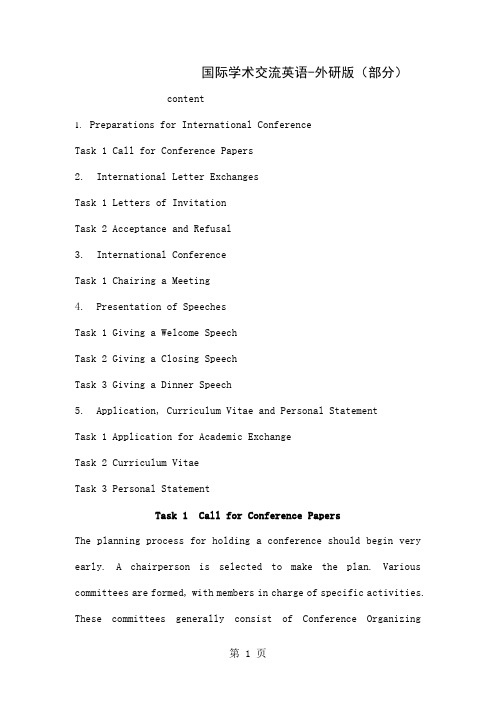
国际学术交流英语-外研版(部分)content1.Preparations for International ConferenceTask 1 Call for Conference Papers2. International Letter ExchangesTask 1 Letters of InvitationTask 2 Acceptance and Refusal3. International ConferenceTask 1 Chairing a Meeting4. Presentation of SpeechesTask 1 Giving a Welcome SpeechTask 2 Giving a Closing SpeechTask 3 Giving a Dinner Speech5. Application, Curriculum Vitae and Personal StatementTask 1 Application for Academic ExchangeTask 2 Curriculum VitaeTask 3 Personal StatementTask 1 Call for Conference PapersThe planning process for holding a conference should begin very early. A chairperson is selected to make the plan. Various committees are formed, with members in charge of specific activities. These committees generally consist of Conference OrganizingCommittee and Conference Academic Committee. The committees are then to work out a general program, including a call for papers, which is to notify the prospective participants of the conference. Format of call for conference papers·Theme and/or background·Conference objectives·Topics to be discussed·Time and venue·Papers and submissions·Organizing institution and committee·Contact informationSampleConference Goals:To promote the study of material science in China; to introduce the development of the research work; to discuss the important issues in the field; to provide opportunities for international communication; to promote the understanding of related disciplines; to explore future cooperation possibilities between the countries. Topics to be Discussed:Papers are solicited on theoretical issues and their applications related to crystal materials. Suggested topics include but are not limited to:Papers and Submissions:Authors are invited to submit full papers, up to six pages, with the authors’ names and affiliations, complete address (including email, fax and phone number of the corresponding author), before April 10,2006, by email to aa@ss. The language is Chinese or English. The papers will be reviewed by the program committee based on content, presentation and suitability for the conference. The papers must be in an MS word or Latex format (A4, single space, Songti, 10 points if in Chinese, or Times New Roman, 12 points if in English). More detailed information will be available on the web page: http://aa. Useful Expressions and Sentence Patterns1. Call for papers·Papers are being invited for TI 83rd World Conference to be held in Shanghai, May 23-27, 2004.·Titles of proposed papers with a 200-word abstract should be submitted no later than May 10, 2006.·The IASTED Secretariat must receive your paper by July 15, 2006. 2. Submission·The submitted papers should be original and have not been published elsewhere.·Best papers will be selected by the Advisory Committee and Program Committee, and the authors are invited to submit their papers toan international journal.·For all submissions, please include the following information: title of the paper, name, affiliation, address, phone number, email, and audiovisual request.·Abstracts are invited for 20-minute talks followed by 10 minutes of discussion addressing any topic in the areas of Asian environmental protection…3. Format and length·Abstracts should be submitted electronically in an MS Word format and sent by email to the conference secretariat.·Authors of accepted papers should send the full text paper in format of PDF or MS Word before September 15, 2006 to aa@ss with attachment.·All submissions should be in Adobe Acrobat (.pdf), postscript (.ps), or MS Word (.doc) format.·Initial paper submissions should be approximately ten pages.4. Notification of acceptance and refusal·Notification of acceptance will be sent via email by August 1, 2006.·Receipt of paper submission will be confirmed by email.·Submissions received after this date will not be given primary consideration.·Acceptance of the paper will be confirmed by JICC 2006 ProgramCommittee based on content quality of the extended abstract.·Late registration fees or paper submissions will result in papers being excluded from the conference proceedings.Called to order by the presiding officer主持人致辞roll call点名announcement of quorum宣布大会决议reading of the minutes of the previous meeting宣读前期会议纪要approval of the minutes of the previous meeting通过前期会议纪要related matters相关事宜unfinished business未尽事宜appointments and removal任命及离任nomination and elections提名及选举adjournment休会opening ceremony开幕式keynote speech主题发言forum论坛plenary session全体会议poster session论文展示panel session专题讨论会discussion / question & answer session讨论/提问与回答时间field trip考察活动closing ceremony闭幕式reception/banquet招待晚宴Task 1 Letters of InvitationBefore the international conference, the conference host or organizer(s) will send invitation letters to famous scholars and experts in the field and invite them as keynote speakers to the conference. They will also invite other prospective authors to present their new ideas, valuable works, and ongoing research at the conference. These letters are formal letters and therefore should bear all the necessary information about the occasion(s), and express the host’s sincerity and hospitality toward the attendees.在国际会议,会议主持人或组织者()将发送邀请信,著名学者在该领域的专家和邀请他们作为主讲人会议。
国际学术交流英语词汇UNIT2
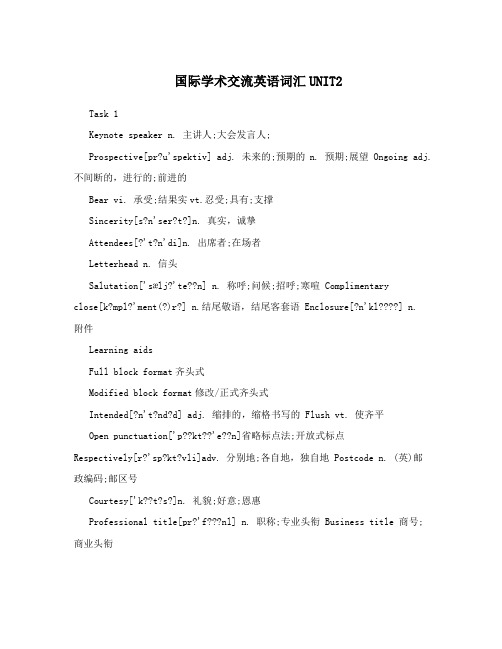
国际学术交流英语词汇UNIT2Task 1Keynote speaker n. 主讲人;大会发言人;Prospective[pr?u'spektiv] adj. 未来的;预期的n. 预期;展望 Ongoing adj. 不间断的,进行的;前进的Bear vi. 承受;结果实vt.忍受;具有;支撑Sincerity[s?n'ser?t?]n. 真实,诚挚Attendees[?'t?n'di]n. 出席者;在场者Letterhead n. 信头Salutation['sælj?'t e??n] n. 称呼;问候;招呼;寒喧 Complimentaryclose[k?mpl?'ment(?)r?] n.结尾敬语,结尾客套语 Enclosure[?n'kl????] n.附件Learning aidsFull block format齐头式Modified block format修改/正式齐头式Intended[?n't?nd?d] adj. 缩排的,缩格书写的 Flush vt. 使齐平Open punctuation['p??kt??'e??n]省略标点法;开放式标点Respectively[r?'sp?kt?vli]adv. 分别地;各自地,独自地 Postcode n. (英)邮政编码;邮区号Courtesy['k??t?s?]n. 礼貌;好意;恩惠Professional title[pr?'f???nl] n. 职称;专业头衔 Business title 商号;商业头衔Capitalized ['kæp?t?lɑ?zd] adj. 大写的 Cordial['k??d??l]adj. 热忱的,诚恳的;兴奋的Ample['æmpl]adj.丰富的;足够的;宽敞的Account[?'ka?nt]n. 账户;解释;账单;vi. 解释;导致;报账Invitee[,?nva?'ti]n. 被邀请者Abbreviation[?'briv?'e??n]n. 缩写;缩写词Accommodation[?,kɑm?'de??n]n. 住处,膳宿Seminar ['s?m?nɑr] n. 讨论会,研讨班R.S.V.P. abbr. (法)敬请赐覆(repondez s'ilvous plait) Tone n. 语气;色调;音调;音色Terminology n. 术语,术语学;用辞Chair a session 主持一个会议Interchange vt.(指两人等)互换vi. 交换;n. 互换;立体交叉道 Panel n. 座谈小组,全体陪审员Preparatory [pr?'pær?t?ri]adj. 预备的n. 预科;预备学校 Symposium[s?m'poz??m]n. 讨论会,座谈会;专题论文集; Covered adj. 覆盖了的;隐蔽着的;有屋顶的 Reimburse [,ri?m'b?s]vt.偿还;赔偿Subsidized adj. 补贴的,补助的Subsistence allowance [s?b's?st?ns][?'la??ns]n. 预付给新进员工的钱;生活津贴Duration [dj?'re??(?)n]n. 持续Registration [red??'stre??(?)n]n. 登记;注册;挂号 Coordinator[k??'?:d?ne?t?]n. 协调者Task 2Promptly ['pr?m(p)tl?]adv. 迅速地;立即地;敏捷地 Familiarize[f?'m?l??ra?z]vt.使熟悉Courteous ['k?t??s]adj. 有礼貌的;谦恭的Alternative [?l't?n?t?v]adj. 供选择的;选择性的;交替的n.二中择一Confirm [k?n'f?m]vt.确认;确定;证实;Participation [pɑr,t?s?'pe??n]n. 参与;分享;参股 Commitment[k?'m?tm?nt]n. 承诺,保证;委托; Prohibitive [pr?'h?b?t?v]adj. 禁止的,禁止性的;抑制的 Colleague [?k?li:ɡ]n. 同事;同行Task 3Via prep.通过;经由Combination [,kɑmb?'ne??n]n. 结合;组合;联合Formality [f?r'mæl?ti]n. 礼节;拘谨;仪式;正式手续 Workshop n. 车间;研讨会;工场;讲习班 Volume n. 量;体积;卷;音量;大量;册 Time-consuming adj. 耗时的;旷日持久的Confined [k?n'fa?nd]adj. 狭窄的;幽禁的;有限制的v. 限制 Impact n. 影响;效果;碰撞;冲击力Specify ['sp?s?fa?]vt.指定;详细说明;列举; Distorted [d?s't?rt?d]adj. 歪曲的;受到曲解的v. 扭曲 Itemized ['a?t?m,a?z]adj. 编位号的;逐项逐笔登记的v. 逐条记载Asterisk ['æst?r?sk]n. 星号vt.注上星号;用星号标出Subheading n. 副标题;副主题词;小标题 Accessible [?k's?s?bl]adj. 易接近的;可进入的;可理解的Emphatic [?m'fæt?k]adj. 着重的;加强语气的;显著的Cyberspeak 网络用语Sparingly ['sp??ri?li]adv. 节俭地;保守地;爱惜地 Decode [计][通信] vt. 译码,解码Cryptic ['kr?pt?k]adj. 神秘的,含义模糊的 On behalf of代表;为了Submission [s?b'm???n]n.提交Entitled [?n'ta?tl]adj. 有资格的;给与名称的 Reservation [,r?z?'ve??n] n. 预约,预订;保留 Track v. 跟踪,追踪Manuscript ['mænjuskr?pt]n. 手稿;原稿。
人民大2023农林国际学术交流英语 PPTunit 2 Urban Agriculture

Task 2
Different types of questions (8) To ask about something not directly tied to the main point of the results E.g. This is probably not your focus, but I’m interested in ... Well, this is just out of curiosity, but ...? Would you tell me more about the techniques that ...? I’m wondering if I could use the same techniques in my research about ... Would you mind if I ask how much fund you have got for this experiment?
Part I Types of Urban Agriculture
Task 1
leisure farm
Task 2
Different types of questions (3) To ask about previously known facts and information in order to inquire any connection with other research E.g. I wonder if you are aware of the data offered by others on ...? Do you know...? There might be some preceding study that examined that. Are there any other methods that you can use to test...?
国际学术交流英语 英语
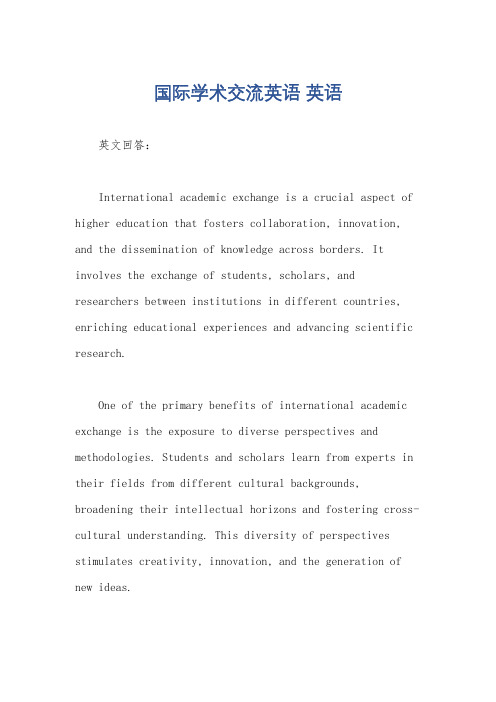
国际学术交流英语英语英文回答:International academic exchange is a crucial aspect of higher education that fosters collaboration, innovation, and the dissemination of knowledge across borders. It involves the exchange of students, scholars, and researchers between institutions in different countries, enriching educational experiences and advancing scientific research.One of the primary benefits of international academic exchange is the exposure to diverse perspectives and methodologies. Students and scholars learn from experts in their fields from different cultural backgrounds, broadening their intellectual horizons and fostering cross-cultural understanding. This diversity of perspectives stimulates creativity, innovation, and the generation of new ideas.International academic exchange also facilitates the transfer of knowledge and skills. Students and researchers gain access to specialized knowledge, cutting-edge research facilities, and advanced technologies through exchange programs. This exposure enhances their academiccapabilities and prepares them for careers in a globalized world.Furthermore, international academic exchange promotes collaboration and networking. Collaborative research projects between institutions in different countries foster interdisciplinary approaches, pooling resources and expertise to address complex global challenges. Networks established through exchange programs facilitate ongoing communication and knowledge sharing, sustaining collaboration beyond the exchange period.Cultural exchange is another significant aspect of international academic exchange. Students and scholars immersed in different cultures develop a deeper understanding of global perspectives, break down stereotypes, and foster empathy for diverse communities.This cultural exchange enriches their personal and professional lives, preparing them to thrive in an increasingly interconnected world.In conclusion, international academic exchange plays a vital role in advancing higher education and research. It promotes intellectual growth, facilitates knowledge transfer, fosters collaboration, and enhances cross-cultural understanding. By embracing international exchange, institutions create opportunities for students, scholars, and researchers to shape a more interconnected and knowledge-driven global community.中文回答:国际学术交流是高等教育中至关重要的一环,它促进了跨境合作、创新和知识传播。
智慧树知到《国际学术交流英语》章节测试答案
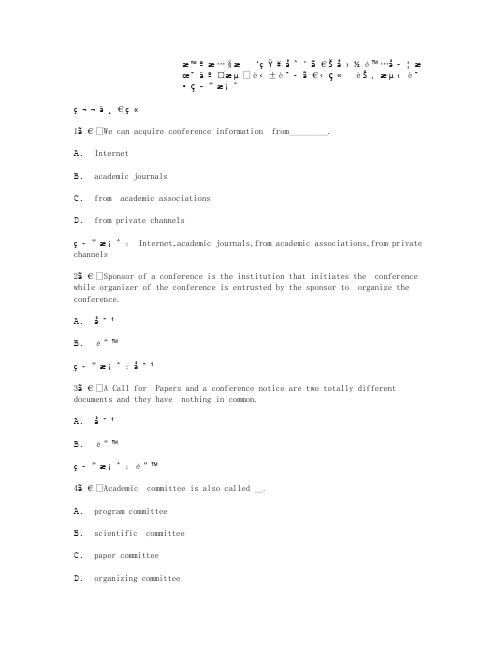
智慧æ‘知到《国际å¦æœ¯äº¤æµ 英è¯ã€‹ç«èŠ‚测试ç”案第一ç«1〠We can acquire conference information from_________.A.InternetB.academic journalsC.from academic associationsD.from private channelsç”案: Internet,academic journals,from academic associations,from private channels2〠Sponsor of a conference is the institution that initiates the conference while organizer of the conference is entrusted by the sponsor to organize the conference.A.对B.é”™ç”案: 对3〠A Call for P apers and a conference notice are two totally different documents and they have nothing in common.A.对B.é”™ç”案: é”™4〠Academic committee is also called __.A.program committeeB.scientific committeeC.paper committeeanizing committeeç”案: program committee,scientific committee,paper committee5〠Which of the following is NOT true concerning “parallel session†?A.Parallel session is smaller-scale meetings which take place at the same timein different rooms.B.Young scholars usually present their papers at the parallel session.C.Parallel session may involve more detailed discussion between authors andparticipants.D.Parallel session doesn’t allow walk-ins and walk-outs.ç”案: Parallel session doesn’t allow walk-ins and walk-outs.第三ç«1〠Which of the following statement about abstract isNOTcorrect?A.An abstract contains key words found in a research paper, thesis, or review.ponents of an abstract vary according to different disciplines.C.An abstract is an excerpted passage from a research paper, thesis, or review.D.The length of abstracts varies according to discipline and the length of thework.ç”案:2〠We write an abstract when ___.A.submitting articles to academic journalspleting and submitting a Ph.D. dissertation or M.A. thesisC.submitting conference papersD.selecting which paper to readç”案:3〠A good abstract should ___.A.be unified, coherent, and intelligible to a wide audienceB.strictly follow the style and formatting guidelines for authorsC.be error freeD.excludes any information that is not based on the content of the paperç”案:4〠According to the linguist Ken Hyland, an abstract of a research paper usually include ___.A.IntroductionB.PurposeC.MethodD.Product and Conclusionç”案:第五ç«1〠Which of the following statement about Q & A session is NOT true?A.Q & A session is usually held immediately after the oral presentation.B.Q & A session only benefits questioners.C.Q & A session is an integral part of academic presentations.D.Q & A session is arranged for most of the international academicconference.ç”案:2〠Before putting forward your question, you need to show your appreciation to the speaker and make a positive comment on his speech.A.对B.é”™ç”案:3〠When asking questions in a Q & A session, you should ____.A.keep your question as short and clear as possiblee the best grammar and pronunciation that you canC.speak loudly and clearlyD.ask as many questions as you canç”案:4〠When answering questions in a Q & A session, you should ____.A.speak clearly and confidentlyB.stay calm and always think about your answer before you speakC.refer back to your notes or previous slides when necessaryD.give more people opportunities to communicate with youç”案:5〠As a speaker, if you don’t know the answer to a particular question, just ignore the question and move on to the next one.A.对B.é”™ç”案:第å…ç«1〠Which of the following statem ent about a personal statement is NOT right?A. A personal statement is your introduction to a selection committee.B. A personal statement is used to supplement the information presented in theapplication with specific examples and convincing facts.C. A personal statement carries the same information as listed in a CV.D. A personal statement helps the committee to learn about you.ç”案:2〠A CV is usually no more than one page whereas the length of a resume is often variable.A.对B.é”™ç”案:3〠In both CVs and resumes, information within sections is usually organized chronologically.A.对B.é”™ç”案:4〠If one part of your academic record is not ideal, due to some challenges you faced in that particular area, you can explain it in your personal statement and direct readers’ attention to the evidence of your promise for the program.A.对B.é”™ç”案:5〠When writing a curriculum vitae, you should _.A.conforms to standard conventions of your fieldB.list every exam you have ever takenC.highlight what is most relevante unusual fonts like Freestyle Script or Old English Text to help youstand outç”案:第二ç«1〠Which is NOT correct about business letter?A. A business letter is an official correspondence between two or more parties.B.Inquiry, recommendation or application letter all belong to the category ofbusiness letter.C.We write a business letter when we need to buy or sell something.D.There are certain rules you have to follow when drafting a business letter.ç”案: We write a business letter when we need to buy or sell something.2〠If you have enclosed any documents along with the letter, you indicatethis by typing “Enclosure†below the signature.A.对B.é”™ç”案: 对3〠“I am writing to you about the possibility of pursuing adoctor’s degree in Finance in your prestigious University.†is an example of ___.A.introducing oneselfB.introducing the purpose of writingC.anticipating a replyD.sending invitationç”案: introducing the purpose of writing4〠To show you are a qualified candidate for an academic program, you can ___ in your application letter.A.give details about GPAB.introduce the research work you have been involvedC.list the awards you have wonD.all answers are rightç”案: all answers are right5〠When writing an application letter, you should make sure it is targeted for the specific program or position.A.对B.é”™ç”案: 对第四ç«1〠If you share something that the audience will find beneficial to know, your purpose of giving the presentation is to _.rmB.persuadeC.inspireD.entertainç”案:2〠Generally speaking, a presentation can be divided into three parts: introduction, body and conclusion.A.对B.é”™ç”案:3〠Well-designed visual aids _.A.improve audience understanding and memoryB.carry your next major ideaC.show that you have a plan and have properly preparedD.helps to create your image as a competent speakerç”案:4〠Which of the following is NOT right when using PowerPoint to support a presentation?A.Keep words on each slide to a minimum.B.Bullet form is a great way to keep information on each slide short andsimple.ing colour contrast can help the message on PPT pop out.D.The more animations and transition effects, the better.。
国际交流英语视听说B2U2

Unit 2Book 2 Culture and TraditionThink and Discuss Viewing the WorldExploring the ThemeAnalytical ListeningSharing Your IdeasEngagingFurther ListeningC ontentUnit 2 Culture and TraditionT hink and Discuss1.Look at the photo. What do youknow about cowboys?2.In which countries do cowboyslive and work?A cowboy and a cowgirlherding horses in Oregon,U.S.AQuestionsQuestions1.Look at the photo. What do you know about cowboys?Example AnswersI know that cowboys ride horses, and their job is to takecare of cows, or cattle. Many cowboys work on ranches,which are farms where cattle and other animals are raised.Questions2.In which countries do cowboys live and work?Example AnswersCowboys live and work in North and South America, from Canada and the U.S.A. to Mexico, Brazil, Argentina, etc.国际交流英语视听说Culture and TraditionUnit 2E xploring the ThemeCulture and Tradition Look at the photos and read the captions. Then discuss the questions.1.Where do these people live?2.How are these people similar?3.What are some cultures that interest you? Why?4.What are some things that make your own culture special?An Argentine gaucho, or cowboy, herdsblack cattle through a field.Culture and TraditionIn Japan, geishas are female entertainers. The wordgeisha means “art person”. Geishas spend a lot of time studying how to perform traditional Japanese music and dances.Culture and TraditionCulture and Tradition The Sherpa people live in Array the Himalayan region. Theword Sherpa means “easternpeople”. The word Sherpaniis used for female Sherpas.guides and help peopleclimb mountains,particularly MountQomolangma.The Roma people lived in India before they moved to Europe. Today,there are many Roma people living in Romania, Hungary, and otherEuropean countries. When Roma children go to a school where people speak a different language, they often stop speaking their Roma language. Scientists estimate that 3,000 languages might disappear in the next 100 years as people stop speaking their native languages.Culture and TraditionCulture and TraditionAborigines are the original people of Australia. There are many different groups of Aborigines living there. Each group has its own language, culture, and customs.In the United States, the Navajo Indians still do their traditional dances, and many speak both the Navajo language and English.Culture and TraditionGauchos are cowboys from Brazil, Argentina, and Uruguay. Gauchos’ work involves moving herds of cattle from one place to another.Culture and TraditionCulture and Traditiongeisha: a woman who works as a traditional Japanese entertainer. Geishas are trained in traditional Japanese arts including singing, dancing, as well as conversation and games. 日本艺妓Culture and TraditionSherpa: a member of an ethnic group living in the Himalayan region. The Sherpas are best-known for their work as expert mountaineers and porters (行李搬运工) who take expeditionsup the mountains in the Himalayas. 夏尔巴人gypsy:a name used to describe a member of the Roma ethnic group. The name comes from a mistaken historical belief that they were Egyptian in origin. The Roma have several different languages and cultures. Most Roma live in Europe, though there are Roma populations in North and South America. 吉卜赛人Culture and TraditionAborigine:a name used to describe people who are historically native to a region. The best-known example is the people who lived in Australia before European settlers arrived. The term “indigenous person” has the same meaning and is usually considered more acceptable. 澳大利亚土著居民Culture and TraditionNavajo Indian: a member of a tribe of native American Indians in the U.S.A. Many Navajo live in the Navajo Reservation ( 纳瓦霍印第安人居留地) which occupies parts of the states of Arizona, New Mexico, and Utah. The Navajo people are famous for their traditional arts and crafts, including weaving and silver jewelry. 纳瓦霍印第安人Culture and Traditiongaucho:a person who rides a horse and works with cattle in parts of South America. Gauchos are famous for their rugged ( 吃苦耐劳的) and independent lifestyle. 加乌乔牧人Culture and TraditionCulture and Tradition 1.Where do these people live?Example AnswersGeishas live in Japan.The Sherpa people live in the Himalayan region.The Roma people live in Romania, Hungary, and other European countries.Aborigines live in Australia.The Navajo Indians live in the United States.Gauchos live in Brazil, Argentina, and Uruguay.Culture and Tradition 2. How are these people similar?Example AnswersThese people represent old cultural traditions in the placeswhere they live. They also represent smaller culturalgroups—not huge populations.Culture and Tradition 3. What are some cultures that interest you? Why?Example Answers• I’m interested in the Hawaiian culture because I think huladancing is beautiful and the Hawaiian Islands are verybeautiful.• I’m interested in the Sami people of Scandinavia because they herd reindeer, their culture and language are very old,and their customs are disappearing quickly.• I’m interested in the culture of Sri Lanka because it has been influenced by several ethnic groups, including theSinhalese (僧伽罗人), Tamil (泰米尔人), etc.Culture and Tradition 4. What are some things that make your own culture special?Example AnswersMy own culture, Chinese culture, is special because it is soancient. Its history goes back thousands of years. Chineseculture is also special because China covers such a largegeographical area, and Chinese food, customs, andlanguages have traveled to many places, includingSingapore, Indonesia, and Malaysia, to name a few.国际交流英语视听说A nalytical ListeningUnit 2Culture and TraditionRobb Kendrick 罗布·肯德里克(人名)Tyrel Tucker 蒂雷尔· 塔克(人名)ranch n. 大牧场Wyoming 怀俄明州(美国西部州)Manuel Rodriguez 曼努埃尔·罗德里格斯(人名)Coahuila 科阿韦拉州(墨西哥东北部州)La Mora Ranch 拉莫拉农场Listening 1Listening 1vaquero: a Spanish word used to describe a man who rides a horse and works with cattle. The vaquero style of working with cattle came historically from Spain to Mexico and spread to California, New Mexico, and Texas in the U.S.A. 牧牛人charro: a kind of traditional cowboy from Mexico. Thecharros are best-known for their colorful hats and clothes, and for their traditional Mexican rodeos (牛仔竞技表演), called charreadas . 墨西哥牛仔Listening 1Prior Knowledge. Discuss the questions with a partner.Before Listening Listening 11.What do you know about cowboys’ lifestyle?2.Besides North America, do you know of any other regions that have cowboys? What arethey called in those places?Cowboy still work onranches in the westernUnited StatesListening 11.What do you know about cowboys’ lifestyle?Example AnswersThe lifestyles of cowboys involve being away from home for long periods, riding horses, and living and working with cattle outdoors.Listening 12. Besides North America, do you know of any other regions that have cowboys? What are they called in those places?Example AnswersBesides North America, there are cowboys called gauchos who live in Argentina, Brazil, and Uruguay. Other cowboys called paniolos live in Hawaii, and vaqueros live in Mexico.A |Listening for Main Ideas.Listen to the first part of the lecture and check(√) the main idea you hear.A LectureListening Listening 1☐The last cowboys disappeared a long time ago.☐Fewer young people want to be cowboys because of the money matters.☐In some parts of the world, there are still traditionalcowboy customs.√Listening 1Professor Daley: OK, so let’s continue. A lot of people today think that the last cowboys disappeared a long time ago. It’s true that there are fewer cowboys today, and the cowboy way of life is endangered. Money is a big factor here. Cowboys usually don’t make a lot of money for all the hard work they do, so fewer young people today want to be cowboys—it’s not an easy lifestyle. Even so, in some parts of the world, cowboys still ride their horses, watch the cattle, and practice traditional cowboy customs.B | Listening for Details.Listen to the entire lecture and complete the notes about the two cowboys.Listening 1•________ years old when the photo was taken•got his first horse when he was_________________•one winter, he worked alone with his_______________ on a ranch •took care of _________ cattle •lived in a shack with no ___________•_____________ the work Tyrel Tucker18two years old older brother2,300electricity enjoyedListening 1 •started working with his father whenhe was _______________•_________ generations of his familyhave worked on the same ranch•got ____________ and moved to thecity•wants to ______________ to thecountryside and work as a vaquero again Manuel RodriguezB| Listening for Details.Listen to the entire lecture and complete the notes about the two cowboys.four years oldfourmarriedmove backC| Making Inferences. Read the statements. Then listen again and check (√) T for true or F for false. The statements are not in the professor’s exact words. You need to think about what you hear.Listening 11. Tyrel liked school.2. Tyrel and his brother ate a healthy diet.3. Both Tyrel and Manuel would be very unhappy living in a big city.4. The two men want to get better jobs.T F ☐☐☐☐☐☐☐☐Listening 1Example Answers1. F (He was happy to leave school at the age of 17.)2. F (They ate the same few foods every day, and didn’t eatvegetables or fruits.)3. T4. F (Tyrel enjoys cowboy work, and Manuel plans to work as acowboy again after his first child is born.)Listening 1D| Discussion. Read the questions. Then listen again and discuss the questions with your partner.1. When did the cowboy tradition start in Mexico? Why?2. Who did the Mexican vaqueros used to work for?3. What did the Mexican vaqueros wear? For whatreasons did they wear those clothes?4. Which part of America did the Mexican cowboys firstmoved into?5. How many kinds of cowboys are there in Mexico today?What are they?Listening 11.When did the cowboy tradition start in Mexico? Why?Example AnswersThe cowboy tradition in Mexico started in the 1600sbecause Spanish people brought cattle to the NewWorld. Workers are needed to take care of the cattle.Listening 1 2. Who did the Mexican vaqueros used to work for?Example AnswersThe Mexican vaqueros used to work for people whoowned big ranches.Listening 13. What did the Mexican vaqueros used to work for?Example AnswersThe Mexican vaqueros used to wear big hats to keep the sun off their faces and high boots to protect their legs.Listening 1 4. Which part of America did the Mexican cowboys firstmoved into?Example AnswersThe Mexican cowboys first moved into Texas in the southern U.S.A.Listening 15. How many kinds of cowboys are there in Mexico today?What are they?Example AnswersThere are two kinds of cowboys in Mexico today. Onekind, called charros, ride horses and compete in sports.The other kind, called vaqueros, work with cattle on the ranches.Critical Thinking.Form a group with two or three other students. Discuss the questions.Listening 1After Listening 1. Why do you think Robb Kendrick used an old kind of camera for his pictures?2. What kinds of people want to be cowboys now?3. Why do you think they like the cowboy’s way of life?4. Would you like this way of life? Why or why not?5. Are there cowboys in China? If yes, what is their way of life like?Listening 11. Why do you think Robb Kendrick used an old kind of camera for his pictures?Example AnswersRob Kendrick used an old camera probably becausecowboy work is an old tradition, and Kendrick wantedthe photos to look old-fashioned, not modern.Listening 1 2. What kinds of people want to be cowboys now?Example AnswersPeople who want to be cowboys now probably likeanimals and enjoy working outdoors, and they don’t expect to make a lot of money or live in luxury.Listening 1 3. Why do you think they like the cowboy’s way of life?Example AnswersThey probably like the cowboy’s way of life because they have a love for freedom.Listening 1 4. Would you like this way of life? Why or why not?Example Answer 1Yes, because I’d like to seek a life of loneliness in the wild nature. I also like freedom and enjoy workingoutdoors, so the cowboy lifestyle would work for me.Listening 14. Would you like this way of life? Why or why not?Example Answer 1No, because it’s important to me to earn enough money to save and invest. I need to live with my family, so the cowboy lifestyle wouldn’t work for me.。
国际学术交流英语U2T2

2. 研究目的
1) This thesis is intended to explore the major technical challenges facing ( the electronic field for many years). 2) This system is designed for (librarians ) to help them (manage the library easily). 3)This thesis concerns the design ( of a special project ) about (choosing a site for school buildings).
3. examines The passage mainly examines the structure of all the novels written by the author in his forties. 4. indicate All the symptoms on the body of the patient indicate immediate surgery.
Task 2 Writing an abstract and a thesis for submission to a conference
Warm-up Questions
• Have you ever written an abstract ? • What items should be covered in an abstract for submission to a conference?
Sample 3 1.aims at • In order to survive the fierce competition in the rubber industry, the factory must aim at developing new models of machines.
国际学术交流英语_2

A Letter of Acceptance of invitation
Dear Dr.Rose Zimbardo, I have received your letter dated December 28, 2004, inviting me to attend the First International Conference on Wireless Innovations: New Technologies and Evolving Policies to be held in Birmingham, England, July, 18-20,2005. Thank you for your invitation. I am pleased to accept your invitation and will send my paper entitled A Preliminary Discussion on Unlicensed Wireless Technologies to the Paper Committee before the required date.
to be held in this university from 14 to16 June, 2004.You will be provided with subsistence allowance and accommodation for the duration of the conference. If you have any enquiries or require any assistance, please do not hesitate to contact our Conference Convener, Ms.Hilary Zhang on (852)2358 8148 or our Executive Officer, Mr. Walter Wang on (852)2358 7850. We look forward to receiving you here.
国际学术交流英语教程

国际学术交流英语教程International Academic Exchange English TutorialUnit 1: Introduction to Academic Exchange- Overview of international academic exchange- Benefits of participating in academic exchange programs- Common challenges and how to overcome themUnit 2: Preparing for Academic Exchange- Researching and selecting a suitable academic exchange program - Application process and requirements- Language proficiency and cultural preparationUnit 3: Communication and Networking- Developing effective communication skills- Building professional relationships with peers and mentors- Navigating cultural differences in an academic settingUnit 4: Academic Writing and Presentation Skills- Formatting and structure of academic papers- Citations and referencing styles- Delivering effective presentations and participating in academic discussionsUnit 5: Research Collaboration and Project Management- Collaborating with international researchers and scholars- Planning and managing research projects- Ethical considerations in international collaborationsUnit 6: Academic Conferences and Publishing- Participating in academic conferences and symposiums- Submitting research papers for publication- Peer review process and dealing with rejectionUnit 7: Funding and Scholarships for Academic Exchange- Exploring funding opportunities for academic exchange- Scholarship applications and writing effective grant proposals- Budgeting and financial planning for international academic exchangeUnit 8: Cultural Immersion and Personal Growth- Embracing and learning from a different culture- Overcoming culture shock and homesickness- Personal growth and development through international academic exchangeUnit 9: Post-Academic Exchange Reflection and Integration- Reflection on the academic exchange experience- Integrating acquired knowledge and skills into future endeavors - Maintaining international connections and opportunities for future collaborationsUnit 10: Case Studies and Success Stories- Case studies of successful academic exchange experiences- Interviews with international students and scholars- Inspirational stories of how academic exchange has impacted their careers and livesNote: This is just a suggested outline for a potential international academic exchange English tutorial. The actual content andstructure can vary depending on the specific focus and goals of the tutorial.。
国际交流英语视听说B2U
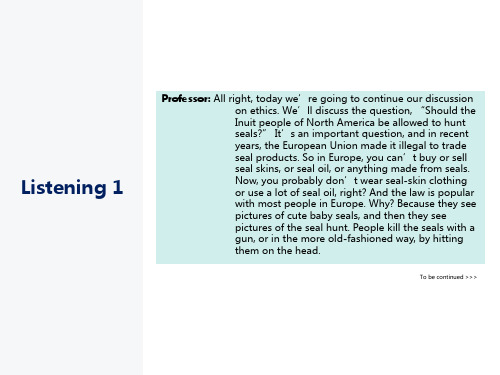
Listening 2
Jack: It’s been a long time, Dakarai! Tell us—how is life in Kariba Town?
Dakarai: Life is pretty good, Jack! The town is growing fast. Jack: I suppose people go there because there’s interesting wildlife
To be continued >>>
Listening 2
Jasmine: Why is it a problem?
Dakarai: It’s the same problem as everywhere else, especially
other places in Africa. There’s a conflict between
Listening 1
Professor: All right, today we’re going to continue our discussion on ethics. We’ll discuss the question, “Should the Inuit people of North America be allowed to hunt seals?” It’s an important question, and in recent years, the European Union made it illegal to trade seal products. So in Europe, you can’t buy or sell seal skins, or seal oil, or anything made from seals. Now, you probably don’t wear seal-skin clothing or use a lot of seal oil, right? And the law is popular with most people in Europe. Why? Because they see pictures of cute baby seals, and then they see pictures of the seal hunt. People kill the seals with a gun, or in the more old-fashioned way, by hitting them on the head.
国际学术交流英语U2T3教案资料
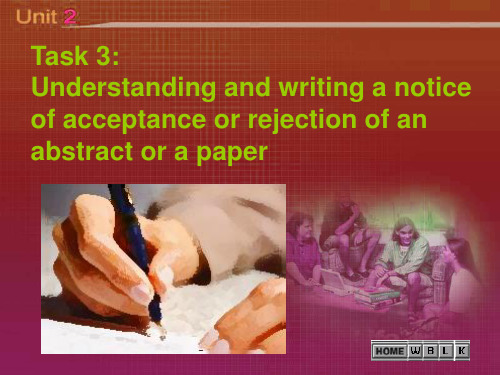
What items should be covered in a notice of acceptance or rejection of an abstract or a paper?
Background Information
Acceptance of the abstract or thesis
Rejection of the
Abstract or Thesis
• If an abstract or thesis is rejected due to certain reasons, a letter of notice should be sent to the writer in due time. A letter of this kind usually should include:
• 2. attach • To the document we attached several
riders, which form an integrated part of the contract we signed last week.
• Sample 2: • via • As soon as we receive your confirmation
a notice of acceptance or rejection
of an abstract or a paper
• Warm-up Questions
Have you ever written ction of an abstract or a paper?
• A letter of acceptance is written to inform the writer that his abstract or thesis has been accepted by the conference committee and he is expected to attend the conference if possible. It usually includes the following:
国际学术交流英语 第二单元

Contact info for enquiries
Vocabulary
airfare: n. transportation charge on airplane cordially: adv. in a friendly but polite and formal way convener: n. sb. who chairs a meeting, committee, etc. Finite or Infinite Dimensional Complex Analysis: 有 限或无限维的复分析 incidental expenses: 附带(发生的)费用 stipend: n. a sum of money that is paid for living expenses. Youngstown: 杨斯顿,俄亥俄州东北部一城市
I wish the conference a successful one.
extending good wishes
Respectfully yours, (signature) Feilong Wang
Tips for Letter Writing
Good letter writing includes proper grammar, punctuation, capitalization, format, structure and addressing persons of title. Be consistent in format. Be brief, succinct, and unambiguous in content. Be courteous and polite in tone.
Sample Demonstration
国际学术交流英语课文翻译

Incorrect gender perceptions are also embedded in most public policies. That governments transfer land almost solely to men, has much to do with perception about, rather than the universal fact of, male responsibility and female dependency. Men are often seen as primary bread winners and women at best as helpers.
译文:社会准则严格地限制妇女的经济选择权,通过 阻止女性继承财产的索求或阻止她们从事工作,限定 她们执行工作的范围,规定照顾孩子是她们的责任, 限制她们的流动性等等。因此,性别歧视在社会准则 和社会观念中已根深蒂固,那么这些变化是如何发生 的呢? 词汇: mobility [moʊˈbɪləti] n. 流动性;移动性;
deserve. That is the inequality about gender-biased
social perceptions and social norms.
译文:这个会议讨论的(内容)很广泛我将专注于
性别歧视的一个方面(的议题),它集中影响着数以 百万计的女性工人,但也许未能得到应有的重视。这 个性别的歧视是由社会观念和社会准则的偏见所造成 的。
译文:同样的性别歧视也存在于许许多多的社会保障体 系之中。例如,具有代表性的,在印度的寡妇只要她们 有一个成年的儿子,有时甚至是只要有成年的男性亲属, 即使再贫困也没有获得养老金的权利。在实践中,关于 男性主义的假设往往被证明是错误的。
2-国际交流英语-课程教学大纲

《国际交流英语(yīnɡ yǔ)》(英才(yīngcái)学院)课程(kèchéng)教学大纲课程(kèchéng)编码:GC15000600课程名称:国际交流英语(yīnɡ yǔ)课程英文名称:English for International Communication总学时:40 讲课学时:32 实验学时:0 上机学时:0 辅导学时:8学分:1.5开课单位:外国语学院大学英语第三教学部授课对象:英才学院学生开课学期:2秋先修课程:综合英语、高级英语主要教材及参考书:教材:周之南、韩晓蕙.《国际交流英语》. 哈尔滨: 哈尔滨工业大学出版社.2012.主要参考书:1. Joyce Slayton Mitchell.《美国本科留学指南》. 北京:群言出版社. 2010.2. 贾卫国.《国际学术交流英语》. 北京:外语教学与研究出版社.2008.3. Robert Day. 《How to Write and Publish a Scientific Paper》. 北京:北京大学出版社. 2006.4. 从丛、李咏燕.《学术交流英语教程》. 南京:南京大学出版社. 2003.5. 冯幼民.《高级英文写作教程》. 北京:北京大学出版社. 2002.一、课程教学目的《国际交流英语》是面向英才学院二年级学生开设的一门英语必修课程。
本课程培养具有能够参与国际事务与国际竞争的高层次国际化人才,体现大学英语教学的人本化服务意识,为学生成功申请国际交流项目提供相关的帮助,更好贯彻落实研究型、个性化、精英式的人才培养理念。
课程介绍了国际交流中的日常交流、学术交流和商务交流三大方面。
通过课程的任务型学习,学生将基本了解日常交流必备的英语知识、申请国外大学的步骤和申请材料的准备,以及国外大学学习生活交流;掌握国际交流中所需的英语各类技能。
教学材料选择真实性场景的语料,为学生提供模拟真实语境进行语言演练。
学术交流英语part2unit1
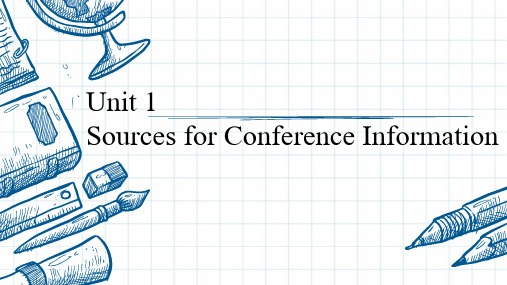
There are websites specific for conference information, among which the following are very helpful and informative:
02
Membership of Professional Organizations,such as societies, associations and federations, can enable you to enjoy the privilege of participating in the organization's activities. Sometimes membership of a professional body is synonymous with qualification and certification, though not always. It is a place for common interests, information sharing and networking.
Unit 1 Sources for Conference Information
0 1 Internet Search Engines and Special Websites 0 2 Membership of Professional Organizations,
Professional Journals and Conference Literature
01
Search engines are the best tools to use when you are looking for specific information or searching for possible meetings to be held in your field. You should learn how to get the MOST from resources and services available online and make effective use of the Internet. In order to retrieve the most relevant documents, you should become familiar with many search engines and their features and learn to use the Internet effectively and efficiently.
国际学术交流英语U2T3省公开课金奖全国赛课一等奖微课获奖PPT课件

11/15
Key Sentences
• 1. 通知收到或接收 • 1) We wish to express our thanks to your
15/15
5/15
• Expressing thanks to the writer;
• Expressing acceptance of the abstract or thesis;
• Expressing good wishes for expecting him to attend the conference.
7/15
• Expressing thanks for the writer’s active participation in the call for paper;
• Specifying the reasons for the rejection, and expressing regret;
12/15
• 3) It is a great honour/pleasure to acknowledge/appreciate/express thanks to (Prof Black ) for presenting the thesis titled (“Study on Stator Field Orientation Control Method ”).
9/15
• 2. attach • To the document we attached several
国际交流英语视听说B2U2

In Japan, geishas are female entertainers. The word geisha means “art person”. Geishas spend a lot of time studying how to perform traditional Japanese music and ns
2. In which countries do cowboys live and work?
Example Answers Cowboys live and work in North and South America, from Canada and the U.S.A. to Mexico, Brazil, Argentina, etc.
Exploring the Theme Culture and Tradition
The Sherpa people live in the Himalayan region. The word Sherpa means “eastern people”. The word Sherpani is used for female Sherpas. Many sherpas work as guides and help people climb mountains, particularly Mount Qomolangma.
- 1、下载文档前请自行甄别文档内容的完整性,平台不提供额外的编辑、内容补充、找答案等附加服务。
- 2、"仅部分预览"的文档,不可在线预览部分如存在完整性等问题,可反馈申请退款(可完整预览的文档不适用该条件!)。
- 3、如文档侵犯您的权益,请联系客服反馈,我们会尽快为您处理(人工客服工作时间:9:00-18:30)。
Sample Demonstration: Acceptancer Professor John Smith,
expressing thanks
Thank you for your letter of April 23, 2006, inviting me to attend the Sixth Asian-Pacific Conference on Wind Engineering to be held in Seoul, Korea, September 12-14, 2006.
Contact info for enquiries
Vocabulary
airfare: n. transportation charge on airplane cordially: adv. in a friendly but polite and formal way convener: n. sb. who chairs a meeting, committee, etc. Finite or Infinite Dimensional Complex Analysis: 有 限或无限维的复分析 incidental expenses: 附带(发生的)费用 stipend: n. a sum of money that is paid for living expenses. Youngstown: 杨斯顿,俄亥俄州东北部一城市
Full block format Semi-block/indented format
Letters of Invitation
Format
Letterhead Date Inside Address Salutation Body Complimentary Close Signature Enclosure (if any)
From: the name or email address of the addresser or the combination To: (the name and/or) the email address of the addressee Subject: the focus/topic of the email Body: purpose in writing the email, details, etc Conclusion: telling what is next or possibly explaining what a follow-up is required Complimentary close Typed name
agreeing to do what was asked closing with thanks
Sincerely yours, (signature) Liu Wen
Sample Demonstration: Refusal
July 5, 2005
Dear Professor Chuck Taylor,
giving reasons for refusal
I am very sorry to inform you that I shall not be able to honor the invitation because I have been suffering from ill health for some time. I am firmly advised that it would be unwise to undertake any distance travel by air in the near future.
Sample: Enquiring about Details
From: Joseph Nacino<Jnacino@ > type in the recipient’s email address To: Wanggang 68@ Subject: Time for the Seminar type in the subject of this email Date: February 6, 2007 Dear Prof. Wang Gang, I am pleased to know that you have agreed to come for a research visit of a couple of days in March 2007 and hold an introductory paper on the seminar for our researchers. What topic are you going to talk about?
English for International Academic Exchange
Unit 2 International Letter Exchanges
Company
LOGO
Unit 2 International Letter Exchanges
1. Letters of Invitation 2. Acceptance and Refusal 3. Writing an Effective Email
The purpose of the conference
The theme of the 19th ICCE is… The conference aims at…
Expecting attendance
We sincerely hope that you can accept this invitation We look forward to meeting you…
Content
Content (the body of the letter)
Extending invitation
On behalf of…, I am pleased to invite you… I am writing to ask if you are willing to present…
expressing thanks
Thank you for your letter of 19 June, 2005, inviting me to attend the International Conference on Education to be held at the National University of Singapore, Singapore, from 6-9 December, 2005, as a part of the NUS Centennial Celebration Conferences.
Vocabulary
anonymous: adj. done, sent, or given by sb. who does not want their names to be known. anonymous review: 匿名评审 faculty: n. school 学院 notification: n. officially informing sb. of sth. p.s.: post script 附言
expressing pleasure to accept the invitation confirming the data and venue
I am pleased to accept the invitation and will send my paper entitled “Climate and Urban Environment Problems” to the paper committee before the required date. Thank you again for your kind invitation and I look forward to meeting you in Seoul.
Vocabulary
centennial: n. a 100th anniversary or its celebration flattering: adj. making sb. look or seem better or more attractive than usual honor: v. to do what you have agreed to do prior: adj. happening or done before a particular time Republic of Korea: 韩国 Seoul: 首尔,韩国首都 the Western Cartographers Association: 地 图绘制协会
Sample Demonstration
Sample 1 Invitation Letter for an Academic Exchange Program
Task 2. Acceptance and Refusal
A letter of acceptance is to inform the conference host/organizer of your acceptance of the invitation and attendance at the conference. A letter of refusal is written if you cannot accept the invitation for one reason or another. You should politely and promptly write to the organizer to decline the invitation. By doing so, you allow them time for arranging backup plans.
